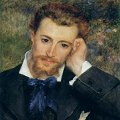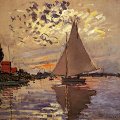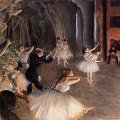Impressionism
 1860 - 1880.
1860 - 1880.  Impressionism is a light, spontaneous manner of painting which
began in France as a reaction against the restrictions and conventions
of the dominant academic art. The hallmark of the style is the attempt
to capture the subjective impression of light in a scene. The core of
the Impressionist group was made up of Claude Monet, Pierre-Auguste Renoir, and
Edgar Degas.
Impressionism is a light, spontaneous manner of painting which
began in France as a reaction against the restrictions and conventions
of the dominant academic art. The hallmark of the style is the attempt
to capture the subjective impression of light in a scene. The core of
the Impressionist group was made up of Claude Monet, Pierre-Auguste Renoir, and
Edgar Degas.
Artists and Articles
Claude Monet
 Claude Monet, French painter, is generally
considered to be the most outstanding figure among Impressionists. The
term Impressionism derives from his picture Impression:
Sunrise. Monet was using the short brush strokes, which often
looked rather like spots of paint, not lines. For this reason his
paintings seemed to some people messy and unfinished. Often, when you
looked at his painting from a short distance you couldn't see what it
was, but if you stepped away you could see a beautiful scene. This was
a completely new way of painting that became the mark of Impressionism. Monet was enormously prolific and many major
galleries have examples of his work. Through his life Monet painted
about 2500 paintings. For many years Monet's and other
Impressionists' paintings were not understood and rejected by people
of that time. But finally by the end of century the new way of
painting became liked and popular. Impressionism enriched art, and
taught people to be open and ready to welcome and enjoy the new
styles. Claude Monet, as the leader of Impressionists, made this
success possible in the big part. Without Claude Monet art would
probably never become so interesting, and full of light, and beauty.
Claude Monet, French painter, is generally
considered to be the most outstanding figure among Impressionists. The
term Impressionism derives from his picture Impression:
Sunrise. Monet was using the short brush strokes, which often
looked rather like spots of paint, not lines. For this reason his
paintings seemed to some people messy and unfinished. Often, when you
looked at his painting from a short distance you couldn't see what it
was, but if you stepped away you could see a beautiful scene. This was
a completely new way of painting that became the mark of Impressionism. Monet was enormously prolific and many major
galleries have examples of his work. Through his life Monet painted
about 2500 paintings. For many years Monet's and other
Impressionists' paintings were not understood and rejected by people
of that time. But finally by the end of century the new way of
painting became liked and popular. Impressionism enriched art, and
taught people to be open and ready to welcome and enjoy the new
styles. Claude Monet, as the leader of Impressionists, made this
success possible in the big part. Without Claude Monet art would
probably never become so interesting, and full of light, and beauty.
 An Interior After Diner (1869)
© Claude Monet
An Interior After Diner (1869)
© Claude Monet
 Ice Floes on the Seine at Bougival (1868)
© Claude Monet
Ice Floes on the Seine at Bougival (1868)
© Claude Monet
- Claude Monet Art, $35
 (250 pictures)
(250 pictures)
- Claude Monet. Life and work.
- Claude Monet. Starting the Impressionism.
- Claude Monet. Colors in Claude Monet's paintings.
- Claude Monet. Best paintings.
Edgar Degas
 Edgar Degas, French painter and sculptor, known
especially for his paintings of ballet dancers. Other subjects that he
frequently returned to include horse races, women bathing, and
portraits of friends and relatives. Degas combined a modern focus on
the creation of unusual compositions and the rendering of movement
with a traditional emphasis on skillful drawing. Degas is usually
classed with the Impressionism, but he stood somewhat
apart from the other artists in this group. He did not share the
Impressionists' fascination with natural light and its effects, and he
disliked painting directly from nature, preferring instead to work in
the studio. Moreover, Degas had little interest in landscape - the
primary subject matter of the Impressionists - and concentrated
instead on the human figure. Also unlike the Impressionists, Degas was
interested in drawing and emphasized line in his work.
Edgar Degas, French painter and sculptor, known
especially for his paintings of ballet dancers. Other subjects that he
frequently returned to include horse races, women bathing, and
portraits of friends and relatives. Degas combined a modern focus on
the creation of unusual compositions and the rendering of movement
with a traditional emphasis on skillful drawing. Degas is usually
classed with the Impressionism, but he stood somewhat
apart from the other artists in this group. He did not share the
Impressionists' fascination with natural light and its effects, and he
disliked painting directly from nature, preferring instead to work in
the studio. Moreover, Degas had little interest in landscape - the
primary subject matter of the Impressionists - and concentrated
instead on the human figure. Also unlike the Impressionists, Degas was
interested in drawing and emphasized line in his work.
 Portraits, at the Stock Exchange (1879)
© Edgar Degas
Portraits, at the Stock Exchange (1879)
© Edgar Degas
 Woman at the Window (1871)
© Edgar Degas
Woman at the Window (1871)
© Edgar Degas
 Woman on a Terrace aka Young Woman and Ibis (1857)
© Edgar Degas
Woman on a Terrace aka Young Woman and Ibis (1857)
© Edgar Degas
 Cafe Concert, At Les Ambassadeurs (1877)
© Edgar Degas
Cafe Concert, At Les Ambassadeurs (1877)
© Edgar Degas
- Edgar Degas Art, $25
 (170 pictures)
(170 pictures)
- Edgar Degas. Life and work.
Pierre-Auguste Renoir
 Pierre-Auguste Renoir, a French painter originally
associated with the Impressionism movement. Renoir's
paintings show vibrant light and color, and harmony of lines. Unlike
many Impressionists who focused on landscapes, he painted not only
landscapes, but people in intimate and candid compositions - sometimes
applying paint with a palette knife rather than a brush. Renoir was
one of the great worshippers of the female form, and he said "I never
think I have finished a nude until I think I could pinch it".
Recognized by critics as one of the greatest and most independent
painters of his period, Renoir is noted for the intimate charm of his
wide variety of subjects. Pierre-Auguste Renoir was undoubtedly one of
the most prolific artists ever with about 6000 paintings
completed during the 60 years he was active as an artist. Two of
Renoir's paintings have sold for more than $70 million.
Pierre-Auguste Renoir, a French painter originally
associated with the Impressionism movement. Renoir's
paintings show vibrant light and color, and harmony of lines. Unlike
many Impressionists who focused on landscapes, he painted not only
landscapes, but people in intimate and candid compositions - sometimes
applying paint with a palette knife rather than a brush. Renoir was
one of the great worshippers of the female form, and he said "I never
think I have finished a nude until I think I could pinch it".
Recognized by critics as one of the greatest and most independent
painters of his period, Renoir is noted for the intimate charm of his
wide variety of subjects. Pierre-Auguste Renoir was undoubtedly one of
the most prolific artists ever with about 6000 paintings
completed during the 60 years he was active as an artist. Two of
Renoir's paintings have sold for more than $70 million.
 Woman with Parasol (1873)
© Pierre-Auguste Renoir
Woman with Parasol (1873)
© Pierre-Auguste Renoir
 A Walk in the Woods (Madame Lecoeur and Her Children) (1870)
© Pierre-Auguste Renoir
A Walk in the Woods (Madame Lecoeur and Her Children) (1870)
© Pierre-Auguste Renoir
 The Reader (1876)
© Pierre-Auguste Renoir
The Reader (1876)
© Pierre-Auguste Renoir
 View of Bougival (1873)
© Pierre-Auguste Renoir
View of Bougival (1873)
© Pierre-Auguste Renoir
- Pierre-Auguste Renoir Art, $39
 (300 pictures)
(300 pictures)
- Pierre-Auguste Renoir. Life and work.
More
Movements
 Art Encyclopedia A world history of art in articles.
Art Encyclopedia A world history of art in articles.
Renaissance
Baroque
Romanticism
Impressionism
Postimpressionism
Modernism
Postmodernism
Art
 Art Wallpapers Art image collections for your desktop.
Art Wallpapers Art image collections for your desktop.
